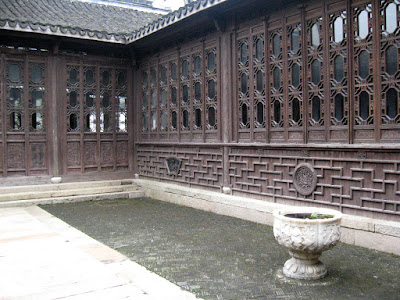Wednesday, October 26, 2011
Headed over to Christine's place near Taipingqiao Park. At the corner of the park:I was accompanying Christine's mother, Brigitte, on a field trip to Fengjing. With a driver, it still took over an hour to get there. I think we were halfway to Hangzhou! And it was such a gray day.
Fengjing is another of Shanghai's water towns, and it is known for "two bridges within three steps and ten creeks visible in a single glance."
Here are the two bridges:
Don't know about the ten creeks.
Wandered into a silk rug workshop:
This lady gestured at our cameras and I was afraid we weren't supposed to take pictures. But finally she got Brigitte to hand over her camera. The weaver looked it over and proceeded to take a photo of Brigitte!
Checkerboard pattern on the plaza:
Jinpu House entrance:
Jinpu House door:
Carved wooden doors:
Courtyard:
Jinpu House is the former residence of Xie Yong, an official during the Qing Dynasty in the 1700s, and it originally included stables and a dock, making it the biggest house in Fengjing.
Stele Lane:
Tour boats:
Someone's back yard and water access:Water gate:
A very small temple to Guanyin, goddess of mercy, who will place children with kind families:
Behind the temple is the Zhihe Bridge, built during the Yuan Dynasty (1271-1368), the oldest bridge in Fengjing.
A memorial built in memory of Gu Wenbing who performed many works of charity. In 1450 he found gold and silver ingots when doing construction. To thank God for this gift from heaven, he built seven, then later six more, wells to bring water to anyone passing by. Here you can see three small wells:
View from Zhihe Bridge:
Ding's Pork Hock Workshop Museum: First the famous Fengjing Black Pig;
Next you butcher the pig, getting the knuckle;
Deep fry the pig's joint;Then serve or package for retail sale.
A bridge with covered seating:
Ming & Qing Dynasty style buildings:
Stone relief carving and red lanterns:
One of the Three Bridges:
Making zongzi:
with glutinous rice, egg yolk, and pork.
Boat landing:
Rainbow Bridge detail:
Rainbow Bridge:
Waterfront property:
Fire House Museum:
Ancient fire engine:
Sign on a trash can:
Filming a TV-spot up on Rainbow Bridge:
View from Rainbow Bridge:
Childhood Residence of Cheng Shifa; carved wooden door:
Courtyard:
Cheng Shifa (1921-2007) was a painter:
Cheng Shifa's work table:
A photo of Cheng Shifa at that table:
He was best known for traditional brush paintings of ethnic minorities in China:
People's Commune Museum:Office with fur-lined great coat;
Dining Hall;
Mao Zedong Pin Collection;Little Red Book Collection;
Anti-aircraft gun and MIG15 plane;
Photo op;
Air Raid Shelter;
This one was bult in 1971.
The Air Raid Shelter "sauna:"
Shelter entrance:
300 Halls Museum:
The first was the Hall of 100 Lamps, then this courtyard with the giant fish basket;
Well;
The bamboo bucket looked waxed inside, but there were holes in the corner.
Next was the Hall of 100 Baskets:
Marriage bed:
Koi pond:
And finally the Hall of 100 Trades. This is Lao Zi, the Originator of Weights and Measures:
We aren't sure what they meant by originator, as they had the originator of butchering and of trading firms, etc.
The trade of embroidery display used a tiny piece of real embroidery:
Shambles?
Looks like butchering.300 House Garden:
From Bridge Three looking towards Bridge Two of the Three Bridges:
A shop for the Fengjing Rice Wine or Yellow Wine:Shiwang Temple:
Monks at work:
Carved stone Chinese zodiac:
Prince Shi and his wife:
After being driven back to Shanghai, we had a late lunch at South Beauty in Xintiandi.


































































No comments:
Post a Comment